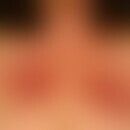Synonym(s)
DefinitionThis section has been translated automatically.
Photoallergically triggered inflammation of the skin after previous specific sensitization, caused by systemically or externally applied, not obligatory phototoxic substances.
Photoallergic dermatitis occurs mainly in exposed areas (see also photoallergy and photoallergen), but in contrast to phototoxic dermatitis, it is not sharply defined and limited to the site of contact.
Occurrence/EpidemiologyThis section has been translated automatically.
In middle-aged or elderly patients who are taking photoallergically effective medication (see below drug reaction, undesirable).
You might also be interested in
EtiopathogenesisThis section has been translated automatically.
Triggered by photoallergenic(see below photoallergenic) substances (also drugs) which enter the skin through local application or systemically and are photochemically stimulated there by UV rays of different wavelengths (mostly UVA rays) (UVB is only triggered in a few cases - e.g. chlorpromazine).
The full antigen, which is produced by different processes, leads to a sensitization and in case of re-exposure to a T-cell-mediated type IV reaction (see below allergy).
Some systemically applied "photoallergens" are also effective as contact allergens, so that the tests are complicated and their significance is only meaningful if the patient's medical history and clinic are taken into account.
LocalizationThis section has been translated automatically.
Primarily exclusively on light-exposed areas. Face with exclusion of the shaded skin regions (chin shadow, retroauricular, axillary), neck, nape, breast region (décolleté); back (dress cut-outs), lower and upper arms (emphasized on the extensor side); back of the hands; in case of prolonged persistence, non-light-exposed skin areas may also be affected.
ClinicThis section has been translated automatically.
The heliotropic macro-pattern is characteristic and thus diagnostically groundbreaking, whereby the micro-pattern shows the picture of chronic polymorphic dermatitis (so-called eczema reaction) of varying acuteity and severity (erythema, papules, papulo-vesicles, extensive scaling and itching).
In contrast to phototoxic dermatitis, the"contact pattern" is not sharply focused on the contact areas but, as in contact allergic eczema, is blurred with "dermatitic scattering foci" beyond the UV exposure site.
HistologyThis section has been translated automatically.
DiagnosisThis section has been translated automatically.
Depending on the suspected photoallergen (photocotactic allergen or systemically applied substance), a photopatch test or systemic photoprovocation may be performed.
Complication(s)(associated diseasesThis section has been translated automatically.
With continued exposure to allergens, the clinical picture can develop into a chronic dermatitis that takes on a life of its own (chronic photoallergic contact dermatitis).
TherapyThis section has been translated automatically.
Note(s)This section has been translated automatically.
The most frequent triggers of photoallergic contact eczema in Europe are currently topical NSAIDs (e.g. ketoprofen, etofenamate) as well as organic light protection filters (e.g. octocrylene, benzophenone-4 as well as butyl-methoxydibenzoylmethane, which is widely used in cosmetic creams with "light protection".
LiteratureThis section has been translated automatically.
- Altmeyer P et al (2007) Dermatological differential diagnosis. Springer Medicine Publishing House
- Giudici PA et al (1985) Experimental photoallergy to systemic drugs. J Invest Dermatol 85: 207-211
- Lehmann P et al (2011) Light dermatoses: Diagnostics and therapy. Dtsch Ärztebl 108: 135-14
- Mahler V (2015) Contact eczema. Act Dermatol 40: 95-107
Incoming links (6)
Bitter orange; Eczema; Hydrastis rhizoma; Isopropyl dibenzoylmethane (inci); Nerolioil; Unripe Bitter orange;Outgoing links (15)
Adverse drug reactions of the skin; Allergy (overview); Antihistamines, systemic; Benzophenone-4 (inci); Betamethasone valerate emulsion hydrophilic 0,025/0,05 or 0,1 % (nrf 11.47.); Desloratadine; Eczema (overview); Etofenamate; Glucorticosteroids topical; Ketoprofen; ... Show allDisclaimer
Please ask your physician for a reliable diagnosis. This website is only meant as a reference.













